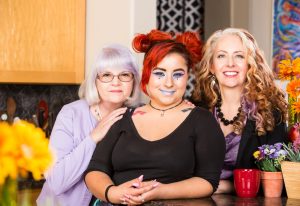Gender, Sexuality and ADHD: Parenting Children and Youth with ADHD Exploring Their Gender and Sexual Identity

Growing, learning and exploring gender and sexuality
Neurodiverse and neurotypical children, teenagers, and young adults are constantly questioning things. As their brain develops, they learn more about themselves and the world around them. Therefore, it’s natural for them to be inquisitive. Part of this curiosity and self-reflection include topics related to values, beliefs and morals, as well as questions of all aspects of identity. Many young adults explore race, religious and cultural identities, as well as gender and sexuality. When the child has ADHD, the unique facets of this condition can influence this process. It takes courage and maturity to explore each of these areas. It’s especially tricky in our Western culture for any adult to acknowledge that they are questioning their gender or sexual identity. It’s a particularly delicate process for children and teenagers. If your child or adolescent approaches you with this topic, they trust you enough to discuss something very personal and possibly uncomfortable.
Supporting your child’s exploration
 Talking through everything with your child can be incredibly emotional for both of you. Therefore, it isn’t something that should be taken lightly. In neurodiverse children–those with ADHD, ASD, 2E, anxiety and more, natural challenges with executive functioning skills can make these conversations even more overwhelming. Above all, breathe, and stay compassionate. Ask more questions than you give advice. This is a private process of discovery that your child has decided to share with you. It can be tough for both of you but in very different ways. Therefore, you should save your reactions and questions for later. Then, direct them to your primary care provider, pediatrician or mental health professional. Your job is to be steady as they navigate this bumpy terrain.
Talking through everything with your child can be incredibly emotional for both of you. Therefore, it isn’t something that should be taken lightly. In neurodiverse children–those with ADHD, ASD, 2E, anxiety and more, natural challenges with executive functioning skills can make these conversations even more overwhelming. Above all, breathe, and stay compassionate. Ask more questions than you give advice. This is a private process of discovery that your child has decided to share with you. It can be tough for both of you but in very different ways. Therefore, you should save your reactions and questions for later. Then, direct them to your primary care provider, pediatrician or mental health professional. Your job is to be steady as they navigate this bumpy terrain.
Language is important
There are a lot of terms related to gender questioning and sexual identity. However, these two processes are not the same and involve different interventions. I encourage you to educate yourself about them. Here’s a short introduction to some of the more common terms:
-
-
Biological sex
Refers to the physical anatomy of a person that identifies them as male, female, or intersex. This includes their physiology (genitalia and body type) and genetic differences (hormones and chromosomes).
-
Gender identity
The way someone perceives themself as male, female, both, or something entirely different. A person’s gender identity can be the same or different from the sex they are assigned at birth. Cisgender people have a gender identity that matches their sex assigned at birth. In contrast, trans people have a gender identity that is different from the sex assigned at birth. This is where appropriate pronouns – like she, he, and they – can be discussed. However, pronouns don’t always match gender identity.
-
Gender expression
The way anyone communicates their gender identity to others. Often, this is expressed through appearance and play choices.
-
Sexual orientation
Defines who a person is physically and emotionally attracted to, based on their own sex/gender. This particular topic can be a little more difficult to work through, though, especially if the parent, guardian, or confidante is less familiar with gender identity.
-
 When your child approaches you with a conversation about their gender or sexual orientation, consider your response before reacting. They are asking you to perceive them differently than you might have before. This can be very difficult to deal with emotionally. No matter how much support and love you give, teens with ADHD quickly pick up on facial expressions and body language that could feel critical. Many kids and teens with ADHD suffer from symptoms of rejection sensitive dysphoria. You should therefore take a giant step backward to look at the entire picture. This will set the tone for your whole family’s response.
When your child approaches you with a conversation about their gender or sexual orientation, consider your response before reacting. They are asking you to perceive them differently than you might have before. This can be very difficult to deal with emotionally. No matter how much support and love you give, teens with ADHD quickly pick up on facial expressions and body language that could feel critical. Many kids and teens with ADHD suffer from symptoms of rejection sensitive dysphoria. You should therefore take a giant step backward to look at the entire picture. This will set the tone for your whole family’s response.
Tips to help you connect with your child and uplift their truth
1. Listen to your child.
We have all been taught active listening at one point or another. However, try reflective listening so they feel heard and validated. Repeat what you hear them say, and avoid giving advice or telling them what to do. If needed, this can happen later. Make sure to pay attention to how you respond. Does it feel like positive feedback or criticism? Avoid interruptions or any responses that could indicate judgment. Right now, your neurodiverse child needs to feel accepted.
2. Acknowledge their courage.
Your neurodiverse child is so brave already. Therefore, opening up and sharing this with you – especially if they struggle with ADHD – is a pivotal and beautiful moment. Let them know how much courage you see in them. Acknowledge their resilience, and let them know that they have made the right decision in opening up the conversation with you. Tell them that you love them for who they are.
3. Avoid standards of gender normativity.

Examine how you view gender in your own life, and reach out to specialists and read literature. Meanwhile, really work to allow your child to feel comfortable and open. Be sure to ask about your child or teen’s preferred name and pronouns. Also ask how you can make changes without feeling like you are walking on eggshells. Above all, respect your child’s privacy and decisions. Remember, the way you interact with your neurodiverse teen will influence the way their siblings and other family members do, too.
4. Help your child make thoughtful decisions.
No matter how accepting and open you and your family may be with your child’s exploration, not everyone is tolerant. Ask them about any times when their gender identity or sexual orientation has been met with nasty, offensive or even dangerous reactions from others. Discuss safety precautions, and explain how hurtful comments and behaviors, no matter how painful they may be, say more about that other person than with your child.
Strategize appropriate verbal and behavioral responses to negative comments and identify caring adults who can offer support. Neurodiverse kids, who may impulsively react to their big feelings that seem unmanageable, will benefit from these solid stand-by tools for heated or hurtful moments. In addition, if things have been tough, and they are feeling particularly overwhelmed, consider letting your child take a mental health day. This can significantly help neurodiverse children and teens rest, regain clarity and regroup.
5. Seek expert help.
You may have questions during this time. Similarly, your child may want to interact with someone else to help them examine their thoughts and feelings. Your usual team of helpers may not have the necessary expertise. Ask trusted health care providers, friends or family to assist you in finding the resources you need. In addition, consider seeking out online resources, parenting groups, therapists, or gender specialists to help your child through this time of self-discovery.
Recommended resources on neurodiversity and gender diversity:

Websites, Organizations & Articles:
- ADDitude Magazine: https://www.additudemag.com/
- American Academy of Pediatrics – Healthy Children: https://www.healthychildren.org
- CDC Resources: https://www.cdc.gov/lgbthealth/youth-resources.htm
- Gender Spectrum: https://www.genderspectrum.org
- GLAAD: https://www.glaad.org
- It Gets Better: https://itgetsbetter.org/
- Movement Advancement Project: https://www.lgbtmap.org
- National Center for Transgender Equality: https://transequality.org
- The Trevor Project: https://www.thetrevorproject.org/
- Trans Youth Equality Foundation: http://www.transyouthequality.org
- Transgender Resources: https://transgenderesources.com
- Trans-parenting: https://www.trans-parenting.com.
- Queerly Autistic: https://queerlyautistic.com/
- Teach.com: “How to Support Gender Sexuality Alliances in Schools”
Related articles by Dr. Saline:
- “How to Support a Teen with ADHD Who Is Questioning Their Gender” By Sharon Saline, Psy.D. and published by ADDitude Magazine (5/12/21)
- “When Children with ADHD Explore Gender Identity: A Guide for Parents” By Sharon Saline, Psy.D. & Julie Mencher, MSW and published by ADDitude Magazine (6/4/21)
Read more blog posts:
